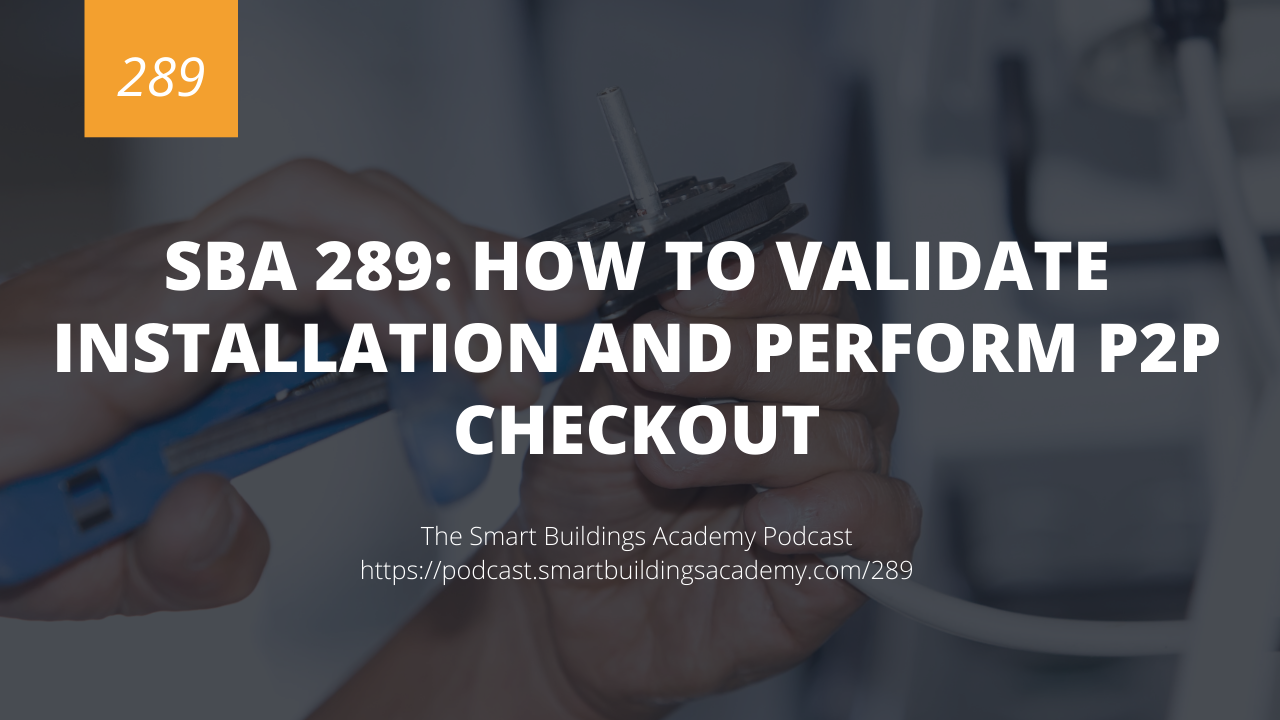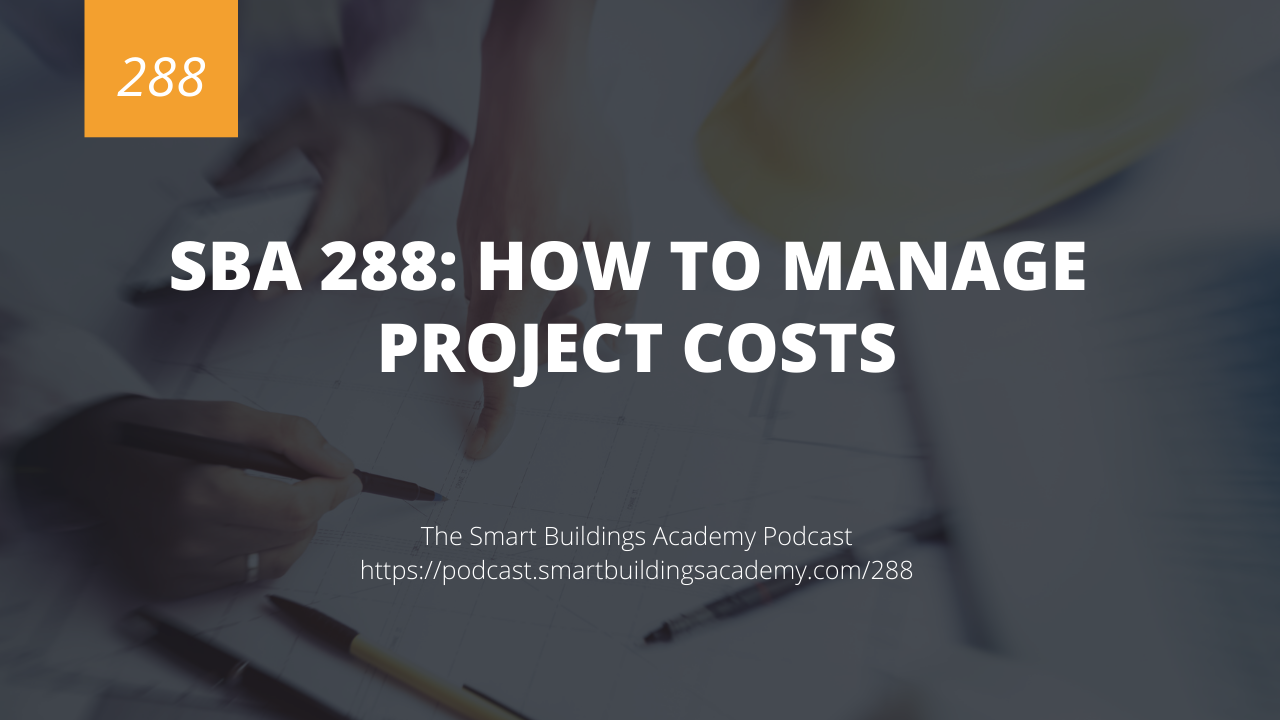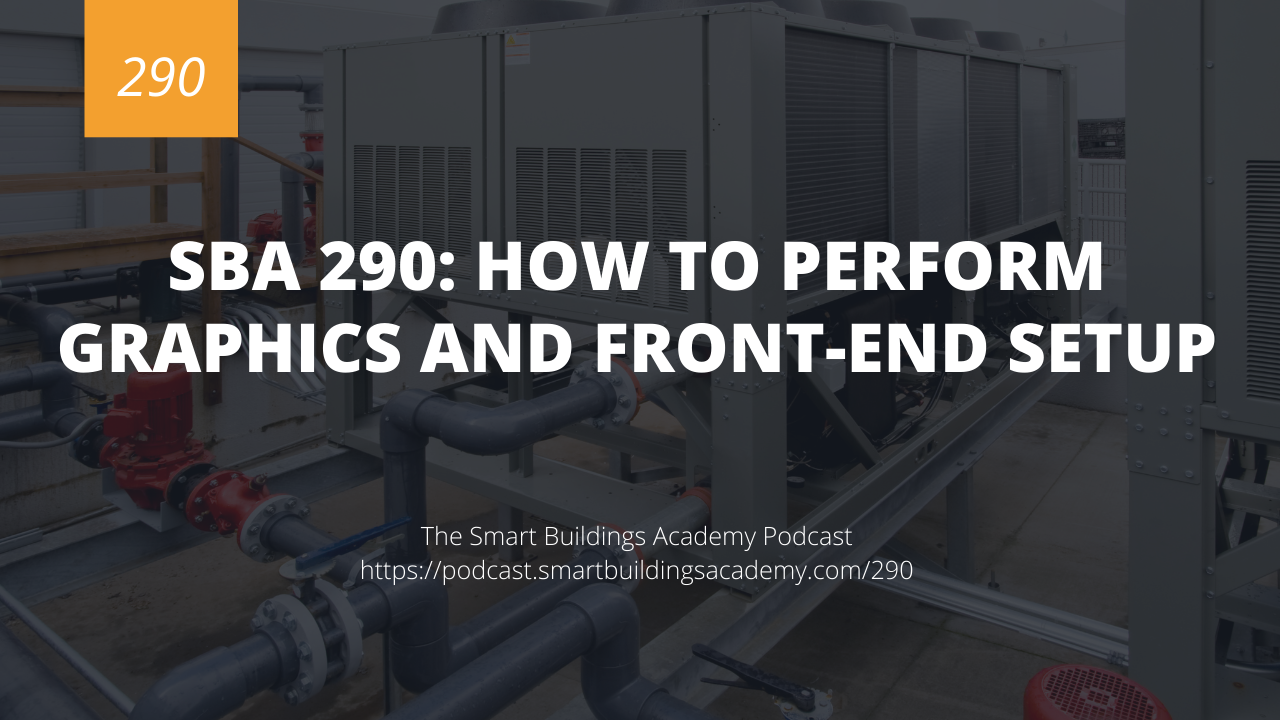n this episode we discuss how to validate installation and how to perform point-to-point checkout on your building automation projects so you can get off your current project and onto the next project.
Click here to download or listen to this episode now.
Resources mentioned in this episode


Transcript
Phil Zito 0:00
This is the smart buildings Academy podcast with Phil Zito Episode 289. Hey folks, Phil Zito here, and welcome to Episode 289. Today is Friday the 15th. And we're gonna actually be knocking out two episodes. So this will be Episode 289. And then I'm going to be recording Episode 290, I had to take my wife to the airport and had to buy a car for my 15 year old daughter. So had the past two days, just got all consumed by everything that was going on. So I'm finally back behind the mic. And we're going to be knocking out two episodes today. So Episode 289 is going to be how to validate, installation and perform Point to Point check out. So if you've been following along this series on construction, which I highly encourage you to start at the beginning, which is Episode 283. And courage you to go through all those episodes, then we've come to the point now, where we've lined out our subcontractors, we've scheduled out our labor, we've created our submittals got them approved, we've ordered our material, our subcontractors have gone and installed the material. And now we need to validate our installation. And we need to perform our point to point checkout. In this episode, we're going to talk through those two things. So validating installation. How do we do this? Well, there's a static installation, and then there is technical installation, and the two are not necessarily the same. You can have something that is wired up properly communicating and performing in a point to point checkout scenario that is completely aesthetically not pleasing. We've talked about this multiple times in the past. And you know, I'm kind of middle of the road here. If you've listened to our podcasts or you've read any of my LinkedIn responses to those panel posts, you know what I'm talking about, you go on LinkedIn, and you see people posting pictures of their panels. And while they look really nice, and I've got flamed for this in the past, I've had people say, Phil, no, this is bad for you to say this. But if my folks are spending that much frickin time on a panel, especially in today's day and age where we're like, barely got staff to go and execute work, something's going on. Because some of these panels, yeah, they look pretty, they look great, have pride in your work, that's awesome. They look over killed, to be honest, like, I'm like, labeling everything kind of wiring. I mean, I know there's I'm going to get emails from you all who are going to tell me that it benefits the person when it comes to troubleshooting, take pride in your work, it takes less time to do things, right, etc, etc. And there's some truth to that. But I'm saying there is a delicate balance between doing things just for aesthetic reasons just for the look. And doing things for practicality. I'm all for using different color wires, or labeling your wires, if it makes sense, right? If it helps the operation of the building, if it helps the operator to actually use the panel. But you know, if it's a commercial office building, and you know no one's ever going to go into the panel, it's not a hospital, does it then make sense to color code, every wired have everything labeled to have everything super pretty? Or does it make more sense to be low cost and get the work executed? Now I'm not saying do spaghetti wiring, and have everything kind of bundled up and you can't make heads or tails out of anything. But at the same time.
Phil Zito 4:04
The level of aesthetics should scale to the level of criticality of the building. And this is something people don't really talk about when it comes to the installation of controls. Once again, I want to be really clear, I'm not saying just go and do crap work. But at the same time, the level of aesthetics you're going to put into a tier four data center or into a very complex operating room are just gonna be different than what you're going to do in a simple investment, commercial real estate property where the person doesn't really care. It's just a nother commercial office building to them and all they're really worried about is getting basic tenants in there. The the level of us that actually are going to put into your installation are going to be different, and that's something that you need to consider when you're approaching things especially in today's day and age where labor is just so hard to come by. So how do we go and validate our installation? Well, the first thing we want to validate is, in my opinion, the communication bus. At the end of the day, the communication bus being improperly installed being improperly terminated is going to be our biggest issue. Sure, we can have issues with point to point. But those are pretty easy to identify. And they're usually impacting one controller unless, like you totally messed up the electrical details in the submittal phase, in which case, they could be impacting all controllers, but that's more on you and less on your installer. So get your submittals right, and then you shouldn't be having that problem if you're getting your submittals right, and you're properly lining out your subcontractors. For more than that, see episodes 285 and 286. Assuming you got your submittals right, and then assuming you lined out your subcontractors, and you train your subcontractors, as I described in those two episodes, then really installation validation just comes to holding them accountable for actually executing what You have taught them and showed them to do. The first of which being communication bus. So you're going to want to make sure that the communication boss has the appropriate separation via j hooks or cable trays. If you're using Ethernet, you want to make sure that the communication is properly terminated on the controllers. So you know the wires the polarities, not crossing the actual, oh my gosh, why is it slipping my brain, it is way too early to be recording podcasts. And that's why slipping my brain, your shield is properly terminated right grounding on one side and not on both sides, not creating an antenna, making sure that your reference wire if you are using a bus that has one is properly terminated as well. Then from there, we move to our addressing of our controllers, validating, addressing, validating mounting of controllers, just want to make sure that's good. And then we can move into point to point now from a point to point perspective, I typically like to do major units, and then spot checks for my terminal units. And that's some folks will advocate for a full point to point to every point. Yeah, you can do that. And some folks will do that. But let's be real. If you have 1000 v v boxes, do you really believe that someone's going around with a multimeter to every thermostat, letting the multimeter set for five minutes or so for the temperature to settle, and then properly calibrate in temperature they're probably not they're probably relying on test and balance to go and help them with calibration. Some test and balance folks do temperature calibration. Others just do airflow. So understanding what your testing balance is going to do more on that in Episode 293. But more importantly, we want to go to our major units, our air handlers and our chillers and our boilers. The reason why is one v v box is messed up, let's say it's temp sensors miswired. Its actuators miswired
Phil Zito 8:12
really shouldn't be because the actuators typically embedded into the controller. But you know, let's say you're using an external actuator, or the heats not properly wired up with fans not properly wired up, that's only going to really affect that one terminal unit and that one space. Whereas if you get an air handler wrong, or you get a chiller wrong, or you get a boiler wrong, that's going to affect all the subsystems that are associated with that primary system. So we really want to be cognizant of that. So that we are going and avoiding, right, we're avoiding issues with major units that are then going to cascade to all the sub units. So if you have to do point to point which I believe you should have to do, you definitely want to do a full point to point on your major controllers for your major handlers and your central utility plant. Now how do you do this, I like to start off with inputs and I like to go and measure the value of the input and make sure that that calibration is properly set. So right we're checking our inputs, we're changing our input states if they're binary, and we're making sure state change corresponds on to the controller, if not, we're reversing the input, or we're rewiring the state of the actual input just depends. And then we want to go to our analog inputs and our analog inputs, we're going to validate those readings as well. There's multiple different ways for tamper humidity, etc to validate and we're going to use those and we're going to compare those and we are going to then put any offsets that are needed in place and then finally we're going to do our safeties. I like to do safeties last because I don't like to forget my safety. And I want to make sure that I do those last always, some folks like to do safeties first, I like to do safeties last. There. The last and final thing I'm going to check, because especially when we get to outputs, there's a specific reason why I like to do this, like the first validate that my output works, especially if it's like a supply fan command, I command it on this, the fan turned on. And then at the end, I'll do like my Low Temp safety or my pressure cut out. And I will make sure that that safety shuts off that command. Whereas if I just make sure the safety works, and then I go and make sure the command works, I'm not really validating that the command is being shut off by the safety. So I want to make sure from a point to point perspective that I do my safeties last after my outputs. Now you're going to have a document typically an Excel sheet, this Excel sheet is going to have your bill of material and your bill of materials is going to correspond to a point name and that point name is then going to correspond to an actual versus tested value. And we're going to put in any offsets, we're going to put our initials next to it that we did point to point and that is how we do point to point and that's how we validate our installation. Now if any of your inputs or outputs aren't working, this is where you would validate your physical installation, make sure it's matching up to the electrical details wired up properly, and making sure that there's no grounds, no shorts, nothing that is potentially going to cause issues. Another thing I like to do, especially if I'm using the power from the controller, and I do have some VA loads that would hit that controller or hit the transformer is like to turn on all the outputs at the same time. And make sure that my transformer still has capability of running those loads. This is especially true with terminal units that maybe have like heat or something. I'll stroke all the dampers at the same time on that controller and turn the heat or the fan commands on at the same time. And then I will make sure that that transformer is not over burdened. Because while a transformer may be fine, when a controller is not doing anything, when that controller actually has a VA load coursing through it. If you're not using primary controller transformers and then secondary Transformers for aios. Then what will happen is as you load that transformer because the controller starting to draw VA, it will become loaded and oftentimes, people will design to an unloaded transformer versus a loaded transformer and soon as you increase outputs, you're going to increase VA soon as you start to stroke actuators you're going to increase VA and that volt Tampere drawl is going to go and cause issues where the transformer can no longer support the load. So you just need to be cognizant of that
Phil Zito 13:06
as you're doing your installation and are validating your installation validating your checkout. So there you have it, validating installation and checkout. As always, everything will be available at podcasts at smart buildings academy.com forward slash 289 once again, that is podcast that smart buildings Academy comm for slash 289 I want to thank all of you who have reviewed the podcast and left us five star reviews on iTunes. Thanks so much that does not go unnoticed. I really do appreciate that. It means the world to me that we are impacting you and that we are helping you we do these podcasts three days a week for free. And all we ask in return is that you share it with others and that you give us a five star review. If we've earned it that really helps more people be able to see the podcast Alright, in the next episode, we're going to talk about performing graphics in front end setup. We're going to talk through what that looks like. And we're in kind of gets you up to speed on that. Thanks, Tom for being here and I look forward to talking to you in the next episode. Take care





